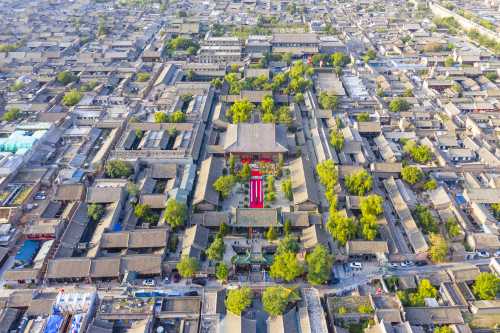Popular Trip Moments
Ancient City Street Scenery | Ancient City of Pingyao: A Fossilized Vibes of Imperial China | The only ancient city in the country preserved because of poverty. | Jade Mansion in Jin: A Luxurious Journey Through Time | Five thousand years seem distant, but Shanxi is close at hand | Shanxi Travelogue: Jinzhong Chapter | Hidden Gems in Shanxi: Jiexiu Mianshan Mountain (Hiking & Ancient Architecture) | Pingyao Ancient City, where every brick and tile tells a story! | The Ultimate Guide to Pingyao Ancient City! A Must-Have for Traveling Through a Thousand Years! | Travelogue of Pingyao Ancient City | Exploring the Wang Family Compound, Embracing Warm Moments at Wenjing Hotel | Top 6 Cities for Budget Travel Suitable for Students: Fewer Crowds and Beautiful Scenery | Pingyao Travel Photography | A Stunning Photo Experience in the Ancient City | Traveling Through a Millennium, De Huai Yuan Awaits Your Relaxation | Popular Landmark | Visit Jinci to See a 3,000-Year-Old Cypress Tree from the Zhou Dynasty. | Pingyao Ancient City, staying here makes you never want to leave—centuries-old architecture | Brick Walls & Time Warps | Temples, Cliffs, and “Wait, Is This Real?” Moments | Pingyao After Dark: Lanterns, Neon & a Surprise Gold Fix | Must-Stay in Pingyao | HuaZhu Baichanghong, Encounter the Slow Life of Ancient Charm | Is Zhangbi Ancient Castle Worth the 75 Yuan Ticket? | One of the hidden gems among Shanxi's ancient architecture: Zhenhelou (River-Pacifying Tower) | Jinzhong Manxin, a haven for the soul at night! | I Thought Datong Was Beautiful Until I Visited This Small City in Southern Shanxi | Pingyao Ancient City: Find Leisure in Seclusion | Pingyao Ancient City: Discover China's Wall Street! | Yuci Old Town ‖ Shanxi Province, Jinzhong | Stay in a cozy "little world" in the Ancient City of Pingyao | Shanxi Jinzhong: Two-Day, One-Night Guide to Lingshi County for 50 Yuan | May Day Getaway | Escape the Crowds with a Road Trip to Taigu Longquan Palace | Super popular 🔥|The Folk Palace Museum·Wang Family Courtyard
Recommended Attractions at Popular Destinations
Attraction near Bangkok | Attraction near Manila | Attraction near Tokyo | Attraction near Taipei | Attraction near Hong Kong | Attraction near Seoul | Attraction near Kuala Lumpur | Attraction near Los Angeles | Attraction near Shanghai | Attraction near New York | Attraction near Shenzhen | Attraction near Osaka | Attraction near Singapore | Attraction near London | Attraction near Guangzhou | Attraction near San Francisco | Attraction near Beijing | Attraction near Macau | Attraction near Bali | Attraction near Jakarta | Attraction near Paris | Attraction near Ho Chi Minh City | Attraction near Istanbul | Attraction near Phuket | Attraction near Chicago | Attraction near Seattle | Attraction near Toronto | Attraction near Orlando | Attraction near Cebu | Attraction near Chiang Mai
Popular Attractions
Universal Beijing Resort | Langkawi SkyCab | Sinan Mansions | Jinjiang Action Park | Suzhou Museum | West Lake | Catacombs of Paris | Shanghai Wild Animal Park | Yas Waterworld | Clark Aqua Planet | Safari World Bangkok | Shanghai Zoo | Yas Island | Pantai Cenang | Dubai Creek Night Cruise | Bangchui Island | Xinshenyun Hanjiang River Cruise | Chuanlord Tourism & Leisure Expo Garden | Bryant Park | Rotes Schloss | Kulturhistorischer Erlebnispfad | Frank Wagner Elementary School Park | Igreja Batista Nova Jerusalém (IBNJ) - Trancoso | Veerabadhra Swamy Temple | Rybník Krčák | Tennis Club | St. Petrus Hommersum | Nagarji Barkheda Soma | South Lake Tahoe Skate Park | La Llorona Multi-Use Path Trailhead
Popular Restaurants in Jinzhong
Hong wu ji Hotel | Ren Zai Bei Fang Restaurant | 德居源 | Xijiebeibaoke Restaurant | 复兴公饭店 | 梁先森·酸奶 | 醉马蘸片则大全(火车站店) | 我在平遥等你旅行者酒吧(平遥古城店) | 喬家老號餐馆 | Wei Yao Resterount | 老介休菜馆(民心小区店) | 湧丰居-又见龙华 | 呷哺呷哺(天美奥莱杉杉店) | Qiaojiazhuangyuan Restaurant | 德克士(介休裕华店) | DE KE SHI XI YANG JIN MEI DIAN | Lao Pingyao Restaurant | 鱼厂·专注香辣烤鱼(介休店) | 平遥麒麟阁酒店·颐景四季厅 | 偶遇酒吧(南大街店) | 喜迎春饭店之三碗不过岗 | 董记炒碗托·裕成源店 | 海底捞火锅(晋中田森汇大学城店) | 祥常泰饭店 | 云锦成·一醋一面(西大街店) | 必胜客(中都店) | Mingyue Restaurant | 海岩咖啡(平遥店) | Guanyunpingyaoniurouqijiandian | 必胜客(奥莱店)
Popular Ranked Lists
Popular Best Things to Do in Xinchang | Popular Must-Visit Restaurants in Chiang Mai | Top 3 Best Things to Do in Panzhihua | Popular Premium Hotels Near Dearborn | Top 10 Must-Visit Restaurants in Bad Ischl | Popular Must-Visit Restaurants in Taipei | Top 8 Local Restaurants in Hanzhong | Popular Luxury Hotels in Astana | Popular Best Things to Do in Wudalianchi | Popular Must-Visit Restaurants in New York | Popular Luxury Hotels Near Higashiagatsuma | Popular Luxury Hotels Near Manzanillo | Popular Must-Visit Restaurants in Chaozhou | Popular Best Things to Do in Huainan | Popular Luxury Hotels Near Province of Palermo | Popular Best Things to Do in Luoping | Popular Must-Visit Restaurants in Osaka | Popular Best Things to Do in Pingxiang | Popular Luxury Hotels in Mirbat | Popular Must-Visit Restaurants in Koh Samui | Popular Must-Visit Restaurants in Melbourne | Popular Must-Visit Restaurants in Santorini | Top 3 Best Things to Do in Chizhou | Popular Luxury Hotels in Oslo County | Top 3 Best Things to Do in Linxia Prefecture | Popular Premium Hotels Near Geraldine | Popular Luxury Hotels Near Etretat | Top 19 Local Restaurants in Singapore | Popular Luxury Hotels in Al Ula | Popular Luxury Hotels in Fes-Meknes
Payment Methods
Our Partners
Copyright © 2025 Trip.com Travel Singapore Pte. Ltd. All rights reserved
Site Operator: Trip.com Travel Singapore Pte. Ltd.
Site Operator: Trip.com Travel Singapore Pte. Ltd.
















